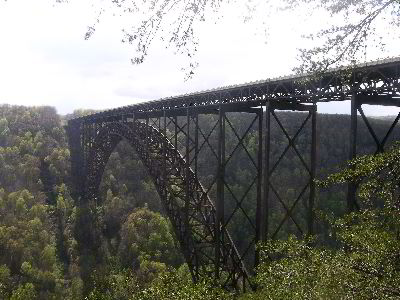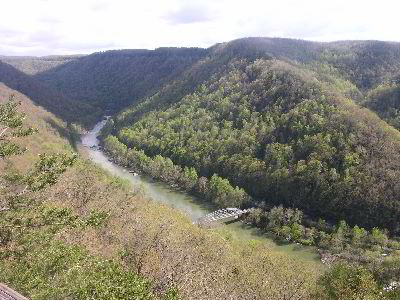|
==============================================================================
TOPIC: New River Gorge Bridge, WV
http://groups.google.com/group/entstrees/browse_thread/thread/85e99b53338cc3b7?hl=en
==============================================================================
== 1 of 1 ==
Date: Mon, Apr 21 2008 9:33 pm
From: "Edward Frank"
April
20, 2008. On the return
trip from the ENTS Moot in Black Mountain, NC I had the opportunity
to stop at the New River Gorge Bridge, mostly because my route
carried me across it. US
19 a four lane highway in West Virginia crosses the Bridge.
The bridge is 3,030 feet long and rises 876 feet above the
new River Gorge. The
New River Gorge Bridge took three years to complete and cost nearly
$37 million. Because of the chosen arch design, and the depth of the
gorge, steel was moved into position by trolleys running on three
inch diameter cables stretched between two 330-foot towers. More
than 88 million pounds of steel are incorporated. Michael Baker Jr.,
Inc. was the design engineer company for the structure, which was
built by the American Bridge Division of US Steel. Its cor-ten steel
will never need painting. The span arches across the New River,
among the oldest rivers in North America, considered to be America's
best whitewater. The New River Gorge National River
is one of three national rivers that are located in the immediate
area. The
other two are: the
Gauley River National Recreation Area and the Bluestone National
Scenic River.
The
Canyon Rim Visitors Center is located immediately off 19 on the
north side of the bridge. From
here are views of the bridge and some trailheads.
The uppermost view looks down on the top of the bridge and
Route 19. The second
set of overlooks are along a boardwalk and looks down on the river
gorge and across to the bridge from the side.
The upper view is wheelchair accessible, the lower is reached
by a series of steps dropping about 200 feet to provide a second
view of the bridge and canyon.
 |
 |
The
New
River Gorge National River was designated in 1978,
protecting 53
miles
of one of the oldest rivers in the world. The gorge averages 1,000
feet
in depth and contains one of the most diverse plant species
assemblages of any river gorge in the southern Appalachians.
Cultural resources include prehistoric sites as well as remnants
from the recent Industrial Age: abandoned coal mines, company towns,
tipples, and coke ovens. Annually,
one million visitors enjoy a full spectrum of recreational
activities. The New River is renowned for its warmwater fishery and
outstanding whitewater boating.
Massive sandstone cliffs challenge rock climbers, while
trails and overlooks offer less strenuous opportunities for
enjoyment.
The
Gorge is a fascinating place that deserves more of a look by ENTS
and other inspired naturalists.
Most of the forest in the canyon walls was uncut.
By around 1900 however because of railroads and coal mines
numerous towns spread along the valley with inherent severe impacts
to the forest in the valley. After
a brief burst of activities most of these towns were abandoned, and
are now in the process of being reclaimed by the forest.
The
park service website states in part:
"New
River Gorge National River lies at the core of the largest remaining
block of relatively unfragmented, mid-latitude forest in the world.
The gorge section of NRGNR supports the most diverse plant
assemblage of any river gorge in the central and southern
Appalachians. This is due, in part, to the moisture gradient
extremes that exist between the rim and river. The park provides
critical habitat for abundant and diverse breeding populations of
migratory birds (including the Cerulean warbler, a species in
decline elsewhere in its range) Also located in the park is the rare
Appalachian Flatrock plant community which includes sedges, cedars
and pines. This plant assemblage occurs on flat sandstone ledges
along the New River and is dependent on the scouring caused by
occasional flooding for its long-term integrity.
Most
of the original deciduous forest stands and understory species have
been impacted by past and current activities associated with
timbering, mining, agriculture, transportation, utilities, and the
exclusion of fire. Internal development projects, increasing
recreational activities, and expanding commercial and residential
influences on the boundary continue to put pressure on a highly
fragmented base resource.
The
New River's origins can be traced back to the birth of the
Appalachian mountains and an ancient river called the Teays. Late in
the Paleozoic Era, 500 million years ago, the North American and
African plates collided, buckling and shattering the earth's crust
and forcing the Appalachians up towards the sky. The Teays River,
with headwaters near present-day Blowing Rock, NC, drained the
slopes of the new mountain range. As the Teays River picked up speed
and power it began cutting through the roots of the old mountains,
all the while maintaining it northerly flow. This action continues
today in the spectacular New River Gorge, where in some place the
river has cut 1500 feet down through the old Appalachians to create
a deep canyon.
Because
the New River is so old, its habitats and wildlife have been able to
achieve a form of stability. Millions of years of available passage
have allowed many species of plants and animals to move in and
persist in the area. Since the New River cuts from east to west
across the Appalachians, we find species that are typically Atlantic
coastal plain and piedmont, such as melic grass, living with
northern mountain species. Because time has favored the new River
Gorge, certain unique species have been able to carve their own
niches here. Several species of fish have evolved that are endemic
(found nowhere else) to this river.
In
the immediate area of the visitors center and the bridge the forests
along the canyon wall look young, but there is a chance to find
isolated pockets of old growth that has been relatively stable
for an extremely long period of time.
We just need to find them.
Ed
Frank
==============================================================================
TOPIC: New River Gorge Bridge, WV
http://groups.google.com/group/entstrees/browse_thread/thread/85e99b53338cc3b7?hl=en
==============================================================================
== 1 of 1 ==
Date: Tues, Apr 22 2008 6:36 pm
From: "Dale Luthringer"
Ed,
I've also thought about exploring the New River Gorge as well. There
is
a particular set of outcrops on the south side of the river uphill
from
the bridge that is at the bottom of the gorge that show twisted tree
forms. I bet with a little bit of exploration, we could come up with
some old stuff. Didn't notice anything that had any serious age
though
adjacent to the visitor center. So far, all my trips there have been
very short. Three years ago was the first time I actually stopped at
the new visitor center, but didn't have any time for exploration. My
wife & I were on our way back from a trip to the Smokies.
Dale
|